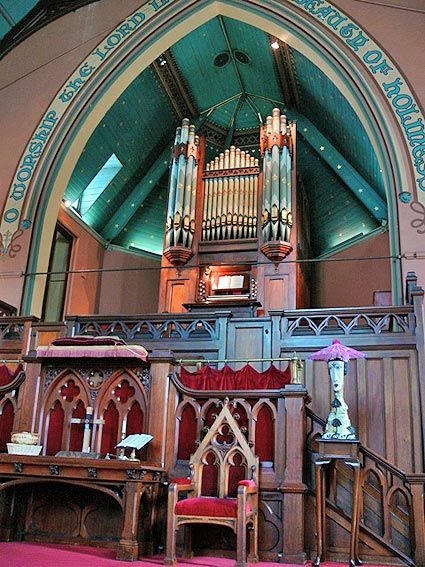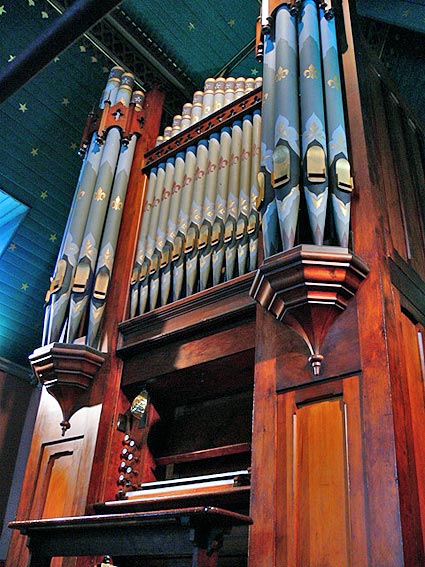Richmond
B 1888 George Fincham; res 1966 Hill, Norman & Beard.
2 manuals, 14 speaking stops, 3 couplers, tracker action
Gt: 8.8 divided.8.4.4.2.8. Sw: 8.8.8.4.2.8. Ped: 16.

The history of Methodism in Richmond dates back as far as 1843 with a Wesleyan Chapel erected in Brougham Street in 1846. In 1853 the foundation stone was laid for the present building in Church Street, the land donated by the Hon. Henry Miller, MLC. Designed by architects Wharton & Burns, it was opened in incomplete state in 1854 and constructed from bluestone rubble. The completed church was opened in 1859, following further work supervised by architects Crouch & Wilson. In 1867 the bluestone façade was stuccoed and in 1873 the porch and a rear gallery, with cast iron balustrade, completed.
The building has a Gothic façade that incorporates an arched porch with quatrefoil frieze, and buttresses capped by pinnacles. The building comprises a nave of five bays, with simple lancet windows unusually still filled with clear glass set in wooden glazing bars. There is a stencilled dado and window friezes comparable with those in the Uniting Church, Brighton, and a painted text in the arch above the organ. The original furnishings largely survive, including cedar pews, pulpit, massive chairs with high Gothic backs, and rails, all in the Gothic style. There are attractive roof trusses of Gothic inspiration, and the ceiling panels are also stencilled.
Three pipe organs have been installed in the church. Details of the first are unknown. The second, built by Forster & Andrews, of Hull, England, was installed in 1877 and in 1888 moved to St Augustine’s Anglican Church, Shepparton where it was destroyed in the 1960s. The present organ was built in 1888 by George Fincham. It has an attractive two-tower case, with stencilled zinc façade pipes and presents a delightful picture in its own apse, high above the choir stalls, the ceiling of which is stencilled with stars.
The instrument has two manuals and 14 speaking stops. It remains in a remarkably intact state with only the loss of the Great Horn rank early in the 20th century. This was later replaced by Hill, Norman & Beard with a very unsatisfactory revoiced Oboe, but very recently a Clarionet 8 to Tenor C has been placed on this slide, with excellent effect. It is both a fine solo stop and adds much in chorus. The pipes are from the 19th century.

| GREAT Open Diapason Rohr Flote Clarabel Dulciana Principal Suabe Flute Flautina Clarionet Swell to Great SWELL Open Diapason Clarabel Keraulophon Gemshorn Piccolo Oboe Tremulant PEDAL Bourdon Great to Pedal Swell to Pedal |
8 8 8 8 4 4 2 8 8 8 8 4 2 8 16 |
CC-BB [Stopped Diapason Bass] TC TC TC [Gedact] [gvd.bass] |
Compass: 56/30
Mechanical key and stop action
3 composition pedals to Great
Trigger swell lever
Attached drawstop console
Historic Churches & Organs of Richmond: notes for Melbourne Autumn Music Festival walking tour 3 May 2003, prepared by John Maidment
Specification noted John Maidment 1966, 2011

Photo: Jim Fletcher
 |
 |
|
 |
 |
|
 |
 |

Photos: JRM (Nov. 2007)